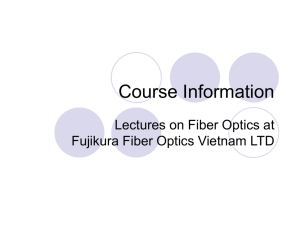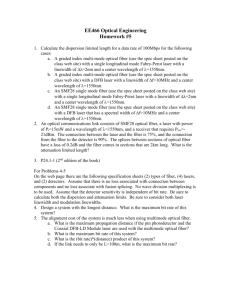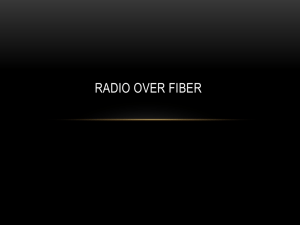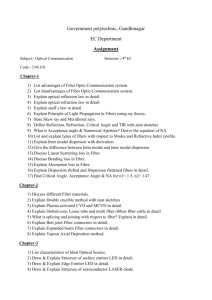google - WordPress.com
advertisement
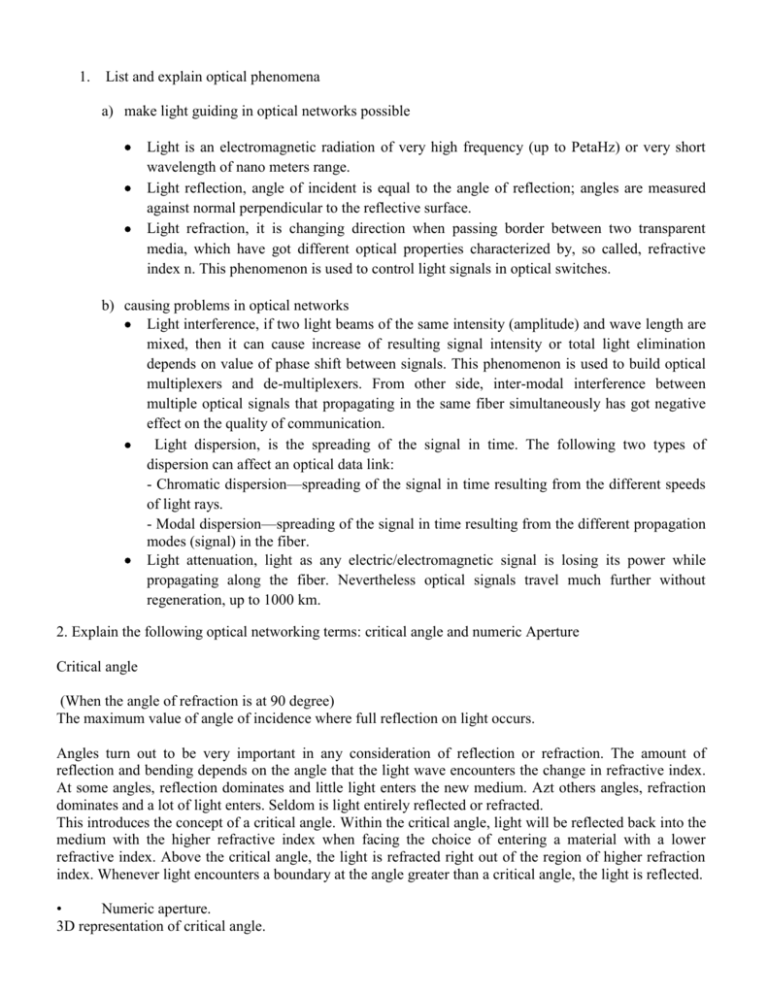
1. List and explain optical phenomena a) make light guiding in optical networks possible Light is an electromagnetic radiation of very high frequency (up to PetaHz) or very short wavelength of nano meters range. Light reflection, angle of incident is equal to the angle of reflection; angles are measured against normal perpendicular to the reflective surface. Light refraction, it is changing direction when passing border between two transparent media, which have got different optical properties characterized by, so called, refractive index n. This phenomenon is used to control light signals in optical switches. b) causing problems in optical networks Light interference, if two light beams of the same intensity (amplitude) and wave length are mixed, then it can cause increase of resulting signal intensity or total light elimination depends on value of phase shift between signals. This phenomenon is used to build optical multiplexers and de-multiplexers. From other side, inter-modal interference between multiple optical signals that propagating in the same fiber simultaneously has got negative effect on the quality of communication. Light dispersion, is the spreading of the signal in time. The following two types of dispersion can affect an optical data link: - Chromatic dispersion—spreading of the signal in time resulting from the different speeds of light rays. - Modal dispersion—spreading of the signal in time resulting from the different propagation modes (signal) in the fiber. Light attenuation, light as any electric/electromagnetic signal is losing its power while propagating along the fiber. Nevertheless optical signals travel much further without regeneration, up to 1000 km. 2. Explain the following optical networking terms: critical angle and numeric Aperture Critical angle (When the angle of refraction is at 90 degree) The maximum value of angle of incidence where full reflection on light occurs. Angles turn out to be very important in any consideration of reflection or refraction. The amount of reflection and bending depends on the angle that the light wave encounters the change in refractive index. At some angles, reflection dominates and little light enters the new medium. Azt others angles, refraction dominates and a lot of light enters. Seldom is light entirely reflected or refracted. This introduces the concept of a critical angle. Within the critical angle, light will be reflected back into the medium with the higher refractive index when facing the choice of entering a material with a lower refractive index. Above the critical angle, the light is refracted right out of the region of higher refraction index. Whenever light encounters a boundary at the angle greater than a critical angle, the light is reflected. • Numeric aperture. 3D representation of critical angle. 2. List and explain 9 major advantages of optical networking (optical cable) versus cooper wire - Higher bandwidth capacity: fiber optic cable is unsurpassed (incomparable) when it comes to high bandwidth and information capacity. - Lower Bit Error Rates: fiber optic cable has lower bit error rates (BERs) than any other transmission medium. - Longer Distances between repeaters: Fiber optic performs so well in the long distances because of the low attenuation on fiber optic cable. - No electromagnetic interference: Fiber will not pick up electromagnetic noise from the environment. - No electrical connectivity needed - Higher security: It is a myth that fiber is more secure than cooper because fiber is difficult to tap into. - Bandwidth upgrades: with DWDM (Dense Wavelength Division Multiplexing), it is possible to expand the bandwidth on the fiber optic link. - Low cost: Fiber optic cable cost less per foot than almost any other cable type. - Small size and Weight: The same size crew (stuff, company) can install much more fiber in one day than any other cable medium. Fibers also offer numerous advantages in terms of size and weight. Optical fiber is a remarkable communication medium compared to other media such as copper or free space. It provides a low-loss transmission over an enormous frequency range of at least 25THz. 4. List and explain drawbacks of an optical fiber. - Problems bending fiber This is the most serious drawbacks of fiber. Most of the light in fiber optic cable travels in the core and is reflected back into the core at the boundary of the cladding and core. The amount of reflection and then the signal kiss is determined by the angle of the light striking the core/cladding boundary. - Problems connecting fiber Connecting should be done in a fashion that minimizes signal loss or attenuation. Naturally, the best way to join fiber optic cable is with a fusion spice. One problem with fusion spices is that they are difficult to do well outdoors when the temperature is low. - Limitations of electrical components This is the most subtle (delicate) drawback. Until more of the network nodes function in a purely optical fashion, fiber optical cable will start and end at electrical devices. 5. Explain the nature of three major types of light dispersion such as material, waveguide and modal - Waveguide dispersion is caused by the shape of the core and RI profile across the core. Waveguide dispersion can actually cause the light pulse to “bunch” in time and disappear. Meaning, if carefully planned WD can counteract the effects of material dispersion. - Modal dispersion occurs in multimode fibers because the distance traveled and hence the arrival time is slightly different for each mode. 6. There are 5 major reasons for the degrading of a pulse of light sent along a fiber optic cable. Attenuation This is always the major concern. A light pulse will always weaken because the fiber absorbs light. The glass itself does not absorb the light but any and all impurities in the glass will. And if the fiber is not manufactured with precise uniformity in diameter and so on, these flaws cause scattering of the light. Scattering effects are the biggest cause of light loss in fiber today. Dispersion This is exactly what it sounds like: a pulse of light become spread out(disperses) in time as it travels down a fiber. Over long enough distances, all the pulses eventually merge together and the peaks needed at the receiver to distinguish 1’s disappear. Power limits One of the overcoming attenuation effects is just to pump up the input power. But the amount of optical power coupled onto a fiber is limited by nonlinear effects. This just means that doubling the input does not double the output but in fact might decrease the output to lower levels than before. Polarization effects The core of the fiber cable should be perfectly round and symmetrical. But there are always imperfections, either in manufacture or during installation, which distort the core in place. As a result, light in the fiber is changed in polarization. Currently, few if any optical network rely on polarization to carry information. But in future systems, polarization effects could be a concern. Noise It might seem odd to speak of noise in an optical network, since immunity from electrical interference is one of the bid advantages of fiber. It is true that optical networks will not pick up noise from outside the network. But noise is just an unwanted signal detected by the receiver. None of these optical impairments are fatal, fortunately. And most can be overcome through a variety of methods. 7. Discuss single mode fiber versus multimode step index fiber and multimode graded index fiber The three types of fiber differ in the way that light travels down them. Single-mode fiber Allows only one mode of light to propagate down the fiber. Here, all of the others modes introduce at the sender interact and cancel each other out (destructively interfer) and only one mode arrives at trhe receiver. Optical networks needing highest speeds and spanning the greatest distances always uses some form of single-mode fiber.. (trick …used) (at very long …1,100nm) (assuming .. very small) Multimode step index fiber Multimode grade index fiber 8. Which of three types of optic fiber that are mentioned in the question 6 are the best for: - Multimode step index (good for LANs) - Single mode step index (good for WANs) - Multimode graded index ( even better for LANs) 9. What is maximum optical reach of optical network link, which employs Raman amplifiers? a) 500 km b) 1000 km c) 2000 km d) 3000 km e) 4000 km 10. Discuss single mode fiber link Vs multimode fiber link in terms of advantages and disadvantages, explain optical phenomena, which are behind these features. The three type of fiber differ in the way that light travels down them. Multimode fibers allow multiple paths, called modes, for the light to travel in them. Single-mode fiber allows only one mode of light to propagate down the fiber. In the single mode fiber, all of the other modes introduced at the sender interact and cancel each other out (“destructively interfere”) and only one mode arrives at the receiver. Multimode fiber are limited in terms of speed and distance because the multiple mode arriving make the job of the receiver more difficult. So optical networks needing the highest speeds and spanning (crossing, bridging, traversing) the distances always use some of the single-mode fiber. 11. Single mode fiber optic link typically provides longer distance connectivity than multimode. Explain this phenomenon Multimode fiber are limited in terms of speed and distance because the multiple mode arriving make the job of the receiver more difficult. 12. . List advantages of a laser over LED (……………….) as an optical transmitter It generates much more powerful signal It faster than LED means it generates much shorter light pulses It generates light of the specific wavelength (cogerent) unlike LED, which generates range of wavelengths, multiple optical signals, in fact Laser is tunable, meaning it can be adjusted to generate various wavelengths 13. What does make avalanche photodiode the most efficient optical receiver The structure is optimized to support the amplification of generated electron-hole pairs before they reach the photodiode electrodes through an internal gain achieved by the process of impact ionization. 14. What is an optical terminal? What is it built of? How does it work? Anything you know about optical terminal Fig: An optical terminal equipped with WDM transponders Optical terminals are optical network devices which have both multiplexing and demultiplexing functionalities. Optical terminals are deployed (installed) at the endpoints of each link. The optical terminal multiplexes the signals from all of the transponders (link between client and optical terminal) onto a single network fiber. In the reverse direction, a WDM signal is carried by the network fiber into the optical terminal, where it is demultiplexed into its constituent (component, integral) frequencies. Each transponder receives its signal on a particular optical frequency and converts it to a client-compatible signal. 15. Functionality of Arrayed waveguide gratings (AWG) The AWGs are used to multiplex channels of several wavelengths onto a single optical fiber at the transmission end and are also used as demultiplexer to retrieve individual channels of different wavelengths at the receiving end of an optical communication network, in other words combine or split optical signals of different wavelength (channels), thus increasing transmission capacity or (AWG) are commonly used as optical (de)multiplexers in wavelength division multiplexed (WDM) systems. These devices are capable of multiplexing a large number of wavelengths into a single optical fiber, thereby increasing the transmission capacity of optical networks considerably. or The AWGs are used to multiplex channels of several wavelengths onto a single optical fiber at the transmission end and are also used as demultiplexers to retrieve individual channels of different wavelengths at the receiving end of an optical communication network. 16. Is that possible to implement full duplex communication over single optic fiber link? If yes, then how can it be achieved? Yes. It can be achieved by using a bidirectional data transmission technology wavelength division multiplexed (WDM) systems which enables data to be transmitted and received simultaneously (bidirectionally) on a single-mode fiber – without restricting the transmission quality and bandwidth. 8. Define spectral width and line-width. Spectral width is a wave of wavelength generated while line width is a weak of single mode. 9. Explain RRR network repeating. There are three essential services on this span. Restore, Reshape and Retime. - A regenerative repeater will restore the power of the signal receiver in the sense that the output power level will be what the transmitter at the repeater is set to generate. - The second function of a repeater is to reshape the pulse that represents the bit. - The last function is to Retime the pulse representing the bits. Retiming is required because a serial digital signal is always constrained by a characteristic bit time. 17. Explain principle and functionality of the following optical networks components: a) Basic cross-connect element 18. List advantages of optical amplifier over optical repeater Optical amplifiers serve to amplify weak incoming optical signals through the process of stimulated emission. (a) Combiner: An S × 1 combiner has S input ports and 1 output port, where S ≥ 2. It collects wavelength channels from all S input ports and combines them onto the common output port. To avoid channel collisions at the output port of the combiner, the collected wavelength channels must be different. (b) Splitter: A 1 × S splitter has 1 input port and S output ports, where S ≥ 2. It equally distributes all incoming wavelength channels to all S output ports. Hence, a given wavelength channel can be received at all S output ports. (c) Waveband partitioner: A waveband partitioner Π has 1 input port and 2 output ports. It partitions an incoming set of Λ contiguous wavelength channels into two wavebands (subsets of wavelength channels) of ΛA and ΛB contiguous wavelength channels, where 1 ≤ ΛA, B ≤ Λ − 1, and Λ = ΛA + ΛB. Each waveband is routed to a different output port. (d) Waveband departitioner: A waveband departitioner Σ has two input ports and one output port. It collects two different wavebands consisting of ΛA and ΛB contiguous wavelength channels from the upper and lower input port, respectively. (e) Passive star coupler (PSC): A D × D PSC has D input ports and D output ports, where D ≥ 2. It works similar to a D × 1 combiner and 1 × D splitter interconnected in series. Accordingly, it collects wavelength channels from all D input ports and equally distributes them to all D output ports. (f) Arrayed waveguide grating (AWG): A D × D AWG has D input ports and D output ports, where D≥2 Single Mode vs Multimode Fiber Single mode fiber: Allows only 1 mode of light to propagate down the fiber Modes introduces at sender interact and cancel each other out (destructive interference) and only 1 mode arrives at the receiver Networks make use of single mode fiber because they rely on high speed and span great distance. Multimode fiber: Allows multiple paths, called modes for the light to travel in them Modes tend to interact with each other in the fiber so modal dispersion is a problem, limiting speed and distance Optical phenomena is reflection, refraction, interference, attenuation, defraction and dispersion Advantages of Optical Transmission - Large bandwidth permits high data transmission, which also supports the aggregation of voice, video, and data - Technological improvements are occurring rapidly, often permitting increased capacity over existing optical fiber - Immunity to electromagnetic interference reduces bit error rate and eliminates the need for shielding within or outside a building - Glass fiber has low attenuation, which permits extended cable transmission distance - Light as a transmission medium provides the ability for the use of optical fiber in dangerous environments Disadvantages of Optical Transmission - Cable splicing: Welding or fusing: you must clean each fiber end, then align and carefully fuse the ends using an electric arc. - Time consuming - Least amount of signal loss between joined elements. Gluing - Bonding material that matches the refractive index of the core of the fiber. - Time consuming - Higher loss of signal power than fusing. mechanical connectors - Considerably facilitate the joining of fibers, - More signal loss than do the other two methods - Can reduce the span of the fiber to a smaller distance.






